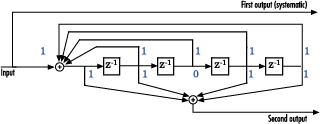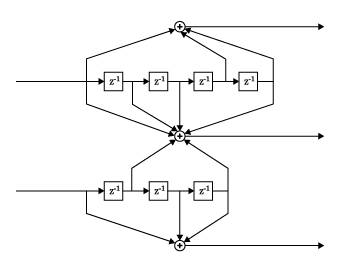convenc
Convolutionally encode binary message
Syntax
Description
codedout = convenc(msg,trellis)trellis.numInputSymbols) bits. The coded output, codedout, contains
one or more symbols, each of which consists of log2(trellis.numOutputSymbols) bits.
Examples
Input Arguments
Output Arguments
More About
References
[1] Clark, George C., and J. Bibb Cain. Error-Correction Coding for Digital Communications. Applications of Communications Theory. New York: Plenum Press, 1981.
[2] Gitlin, Richard D., Jeremiah F. Hayes, and Stephen B. Weinstein. Data Communications Principles. Applications of Communications Theory. New York: Plenum Press, 1992.
[3] Yasuda, Y., K. Kashiki, and Y. Hirata. “High-Rate Punctured Convolutional Codes for Soft Decision Viterbi Decoding.” IEEE® Transactions on Communications 32, no. 3 (March 1984): 315–19. https://doi.org/10.1109/TCOM.1984.1096047.
[4] Haccoun, D., and G. Begin. “High-Rate Punctured Convolutional Codes for Viterbi and Sequential Decoding.” IEEE Transactions on Communications 37, no. 11 (November 1989): 1113–25. https://doi.org/10.1109/26.46505.
[5] Begin, G., D. Haccoun, and C. Paquin. “Further Results on High-Rate Punctured Convolutional Codes for Viterbi and Sequential Decoding.” IEEE Transactions on Communications 38, no. 11 (November 1990): 1922–28. https://doi.org/10.1109/26.61470.
Extended Capabilities
Version History
Introduced before R2006a
![Diagram of a rate 1/2 feedforward convolutional encoder with codegenerators [6 7] and constraint length 3](../../examples/comm/win64/TrellisStructFor12FeedforwardConvEncoderExample_01.png)

